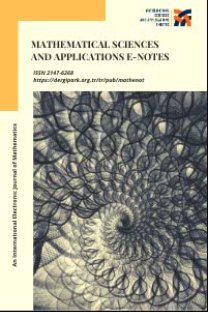Mathematical Modeling of Dengue Disease under Random Effects
Mathematical Model, Random Effect, Simulation, Laplace Distribution,
___
- [1] Bailey, N., The Mathematical Theory of Infectious Diseases and its Applications, Griffin, London, 1975.
- [2] Bhatt, S., Gething, P.W., Brady, O.J., Messina, J.P., Farlow, A.W., Moyes, C.L. et al., The global distribution and burden of dengue. Nature, 496 (2013), 504-507.
- [3] Brady, O.J., Gething, P.W., Bhatt, S., Messina, J.P., Brownstein, J.S., Hoen, A.G. et al., Refining the global spatial limits of dengue virus transmission by evidence-based consensus. PLOS Negl Trop Dis 6 (20120), no. 8.
- [4] Bronson, R., Schaum’s Outline of Differential Equations, 4th Edition, McGraw-Hill Education, New York, 2014.
- [5] Butcher, J.C., Numerical Methods for Ordinary Differential Equations, John Wiley & Sons, New York, 2008.
- [6] Cyganowski, S., Kloeden, P. and Ombach, J., From Elementary Probability to Stochastic Differential Equations with MAPLE , Springer-Verlag, New York, 2001.
- [7] Dietz, K., Transmission and control of arbovirus diseases. In D. Ludwig and K. L. Cooke, editors, Epidemiology, 104–121. SIAM, 1975.
- [8] Esteva, L. and Vargas, C., Analysis of a dengue disease transmission model. Mathematical Biosciences, 150 (1998), 131-151.
- [9] Feller W., An Introduction to Probability Theory and Its Applications, Volume I, 3rd Edition John Wiley & Sons, Inc., New York, 1968.
- [10] Feller W., An Introduction to Probability Theory and Its Application, Volume II, John Wiley & Sons, Inc., New York, 1971.
- [11] Imran, M., Hassan, M., Dur-E-Ahmad, M. and Khan, A., A comparison of a deterministic and stochastic model for Hepatitis C with an isolation stage. Journal of Biological Dynamics, 7 (2013), no. 1, 276-301.
- [12] Kermack, W.O. and McKendrick, A.G., A Contribution the Mathematical Theory of Epidemics. Proceedings of The Royal Society A, 115 (1927), no. 772, 700-721.
- [13] Kloeden, P.E. and Platen, E., Numerical Solution of Stochastic Differential Equations, Second Edition, SpringerVerlag, New York, 1995.
- [14] Kolmogorov A. N., Foundations of the Theory of Probability, Chelsea Publishing Company, New York, 1956.
- [15] Lahrouz, A., Omari, L., Kiouach, D. and Belmaati, A., Deterministic and Stochastic Stability of a Mathematical Model of Smoking. Statistics and Probability Letters, 81 (2011), 1276-1284.
- [16] Martcheva, M., An Introduction to Mathematical Epidemiology, Springer Science+Business Media, New York, 2015.
- [17] Merdan M., Bekiryazici Z. and Kesemen T., Stochastic and Deterministic Stability of Models for Hepatitis C, 7th International Conference on Mathematical Analysis, Differential Equations and their Applications, September 2015, Baku, Abstracts Book, p. 114.
- [18] Merdan, M., and Khaniyev, T., On the Behaviour of Solutions under the Influence of Stochastic Effect of Avian-Human Influenza Epidemic Model. International Journal of Biotechnology and Biochemistry, 4 (2008), no. 1, 75-100.
- [19] Pang, L., Zhao, Z., Liu, S., Zhang, X., A Mathematical Model Approach for Tobacco Control in China. Applied Mathematics and Computation, 259 (2015), 497-509.
- [20] Phaijoo, G.R. and Gurung, D.B., Mathematical Study of Biting Rates of Mosquitoes in Transmission of Dengue Disease, Journal of Science. Engineering and Technology, 11 (2015), no. 2, 25-33.
- [21] Shiryayev A. N., Gradute Texts in Mathematics: Probability, Spring Science+ Business Media, LLC, New York, 1984.
- [22] Soong, T.T., Random Differential Equations in Science and Engineering, Academic Press Inc., New York, 1973.
- [23] Tan, W. and Wu, H., Stochastic Modeling of the Dynamics of CD4+ T-Cell Infection by HIV ad Some Monte Carlo Studies. Mathematical Biosciences, 147 (1998), 173-205.
- [24] Yaacob, Y., Analysis of a Dengue Disease Transmission Model without Immunity. Matematika, 23 (2007), no. 2, 75-81.
- [25] World Health Org., Dengue and severe dengue, http://www.who.int/mediacentre/factsheets/fs117/en/, 23 March 2016.
- ISSN: 2147-6268
- Yayın Aralığı: 4
- Başlangıç: 2013
- Yayıncı: -
Kwara NANTOMAH, Edward PREMPEH, Stephen Boakye TWUM
Fatima BENZİADİ, Abdeldjebbar KANDOUCİ
Tanju KAHRAMAN, Hasan Hüseyin UĞURLU
Zafer BEKİRYAZİCİ, Mehmet MERDAN, Tülay KESEMEN, Mohammed NAJMULDEEN
Ugur ULUSU, Fatih NURAY, Ekrem SAVAŞ
